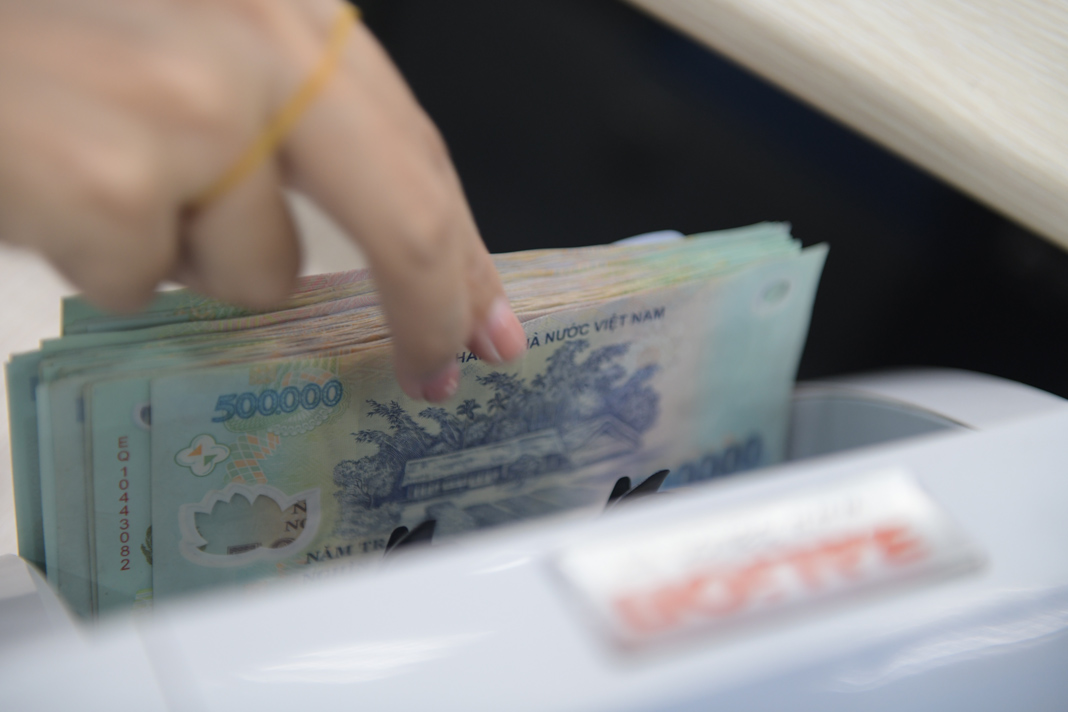Although their business performance has remained impressive, bank stock prices have plummeted on the stock market. The stock market has turned bearish and the banking system has been struggling with unfavorable market conditions.
Impressive profit growth
The Q3 earnings season is almost over, with banks being among the sectors whose business results have remained positive. Seven banks reported over VND10 trillion in profit in the first nine months of the year. Vietcombank earned VND24.94 trillion, Techcombank VND20.8 trillion, VPBank VND19.83 trillion, MB VND18.19 trillion, BIDV VND17.67 trillion, VietinBank VND15.76 trillion and ACB VND13.5 trillion. The remaining three spots in the list of the 10 most profitable banks went to SHB with VND9.03 trillion, HDBank with VND8.01 trillion and VIB with VND7.8 trillion.
Compared to the list compiled in the previous period, the entries remain unchanged, but their order is different. For example, VPBank rose to the third position with a sharp increase in earnings. This banking institution earned an irregular income in the third quarter from its exclusive insurance agreement with AIA. Another change in the ranking is that SHB’s profit shot up 79%, taking this lender to the eighth spot, surpassing HDBank and VIB.
Out of 28 banks that have releases their earnings reports, only one has reported a loss in the first nine months of the year, namely NCB. The bank incurred a loss of VND199 billion in the third quarter and an overall VND180 billion in the first nine months. This is because NCB has repaid interest, stopped accruing and made provisions for overdue and bad debts while also setting aside a certain sum as a risk provision under its restructuring plan. Among the 27 banks that posted profit, OCB and Kienlongbank registered lower profit than the same period last year. In specifics, OCB achieved a nine-month pre-tax profit of nearly VND2.65 trillion, down 29.7%, while the respective figures of Kienlongbank were VND513 billion and 41.6%. Kienlongbank’s profit fall is ascribed to the irregular income from the sale of STB shares in the first quarter of 2021.
Where is the source of motivation?
One thing in common in the profit growth engine of big banks such as BIDV, MB and ACB is that the cost of risk provisions in the first nine months of 2022 was lower than in the same period last year (down 17% at BIDV, 26% at MB, and a whopping 94% at ACB). With the positive results from their core business operations, these three lenders made it to the list of banks with the highest profit growth (over 50%) in the first nine months of the year.
A deeper look into their earnings shows how impressively banks had maneuvered under uncertain market conditions, especially since the third quarter when credit growth significantly cooled and borrowing costs escalated. Most lenders are stepping up the diversification of their revenue streams, especially from services such as cards, insurance, and letters of credit.
VIB is one of the banks that registered profit growth of over 40% in the first nine months of 2022. Its pre-tax profit amounted to VND7.8 trillion, a surge of 46% over the same period last year. In the period, the bank made more than VND2.4 trillion as non-interest income, making up 17% of its total operating income. Meanwhile, Sacombank’s profit before tax was VND4.44 trillion in January-September, up 36% year-on-year and accomplishing 84% of its plan for the whole year. Non-interest income contributed 39% to its total operating income, with financial earnings from services accounting for nearly 24%. As for Techcombank, fee collections from card services leaped 69.5% to over VND1.39 trillion, while fee collection from insurance services picked up a staggering 50% over the year-ago period, with annual premiums in the third quarter spectacularly growing 104% against the same period last year. Thanks to the significant contribution from its income from services, Techcombank reported pre-tax profit of more than VND20 trillion between January and September, up 21% over the same period in 2021.
Besides the shift in revenue streams, as mentioned above, another notable change in the credit structure has helped many banks maintain their profitability. The second and third quarters saw multiple banks boost their retail lending for a high net profit margin to adapt to the stagnant corporate bond and real estate markets. At VIB, where retail remains the focus of attention, outstanding consumer loans have totaled more than VND200 trillion, among the highest figures for private banks. The proportion of consumer loans at VIB has exceeded 90%, with this bank as one of the leading players by auto loans and credit cards nationwide.
Besides VIB, ACB is another bank that enjoyed certain advantages thanks to its great importance to retail banking. Its credit portfolio emphasizes the retail segment with a proportion of 94%. ACB reaped pre-tax profit of VND13.5 trillion in the first nine months of the year, a rise of more than 50% over the same period in 2021, meeting as much as 90% of its full-year plan. The return on equity was over 27% at the bank. At Techcombank, outstanding loans to individual customers grew 61.2% year-on-year to VND222.4 trillion, making up 49% of its credit portfolio (versus 36.4% in the same period last year). Meanwhile, outstanding loans to small and medium-sized enterprises increased 22.7% over the same period last year, while credit to major corporate clients (including loans and bonds) declined 12.5% year-on-year.

Digital transformation is one of the most important factors for positive business results for banks today. The emphasis on retail lending and the promotion of income from services (cards, insurance, etc.) both need digitization. Furthermore, digitization also helps banks control their operating costs efficiently. Along with the boost in staff productivity, some banks’ cost-to-income ratio has also improved significantly. For example, year-on-year, the ratio went down from 40% to 34% at VIB, from 24.8% to 21.2% at SHB, and from 34.9% to 33.7% at Vietcombank.
Unfortunately, although their business performance has remained impressive, bank stock prices have further plummeted on the stock market. This is due to the general stressful situation the stock market is grappling with, plus the challenges the banking industry will have to tackle in the coming time: limited room for credit growth, soaring interest rates and a possible surge in risk provisions. Once all the hardships are over, bank stocks might be one of the first to rebound strongly.









